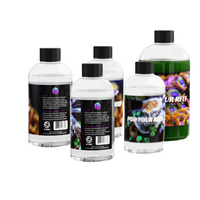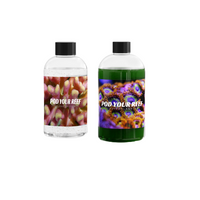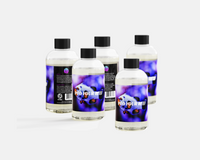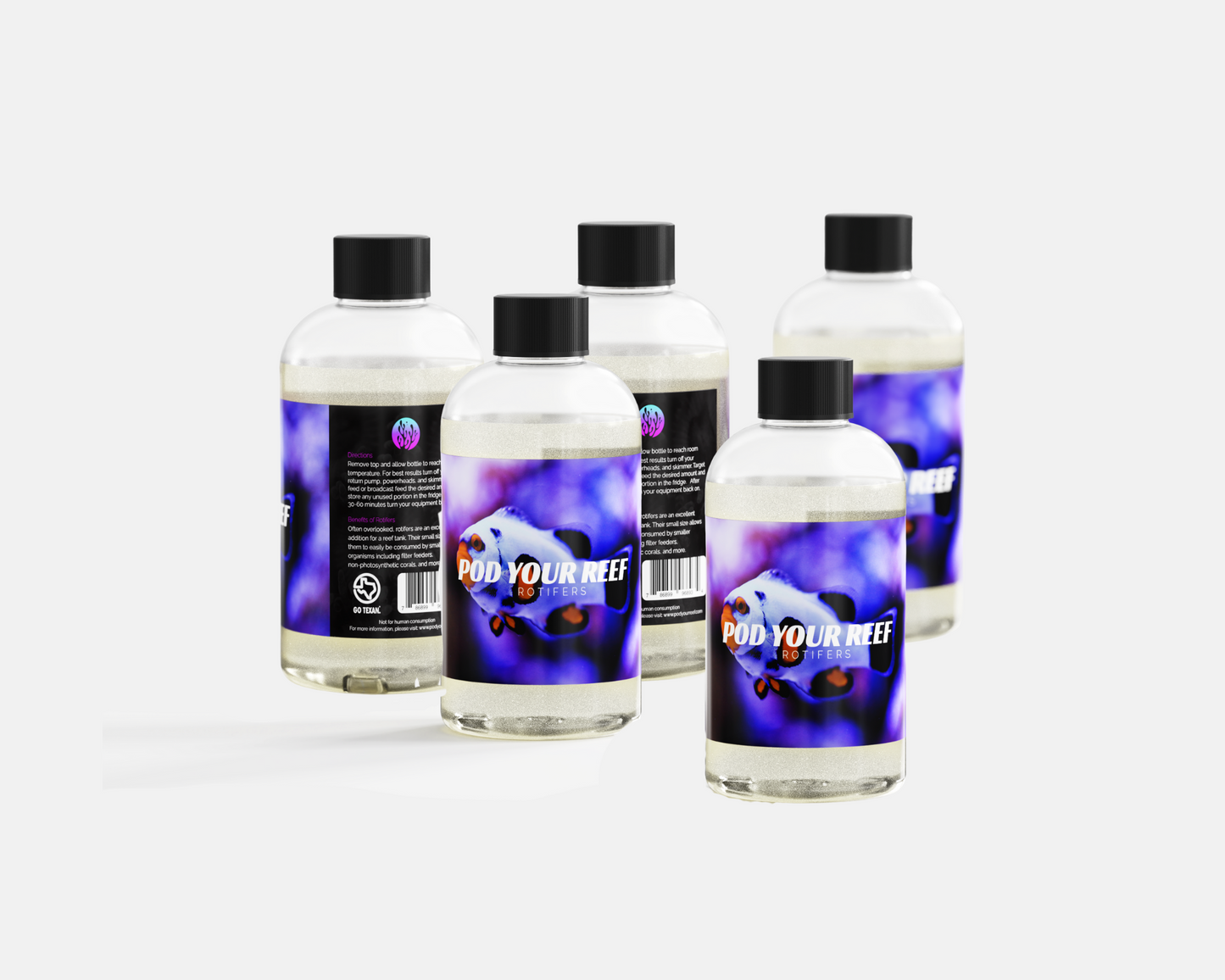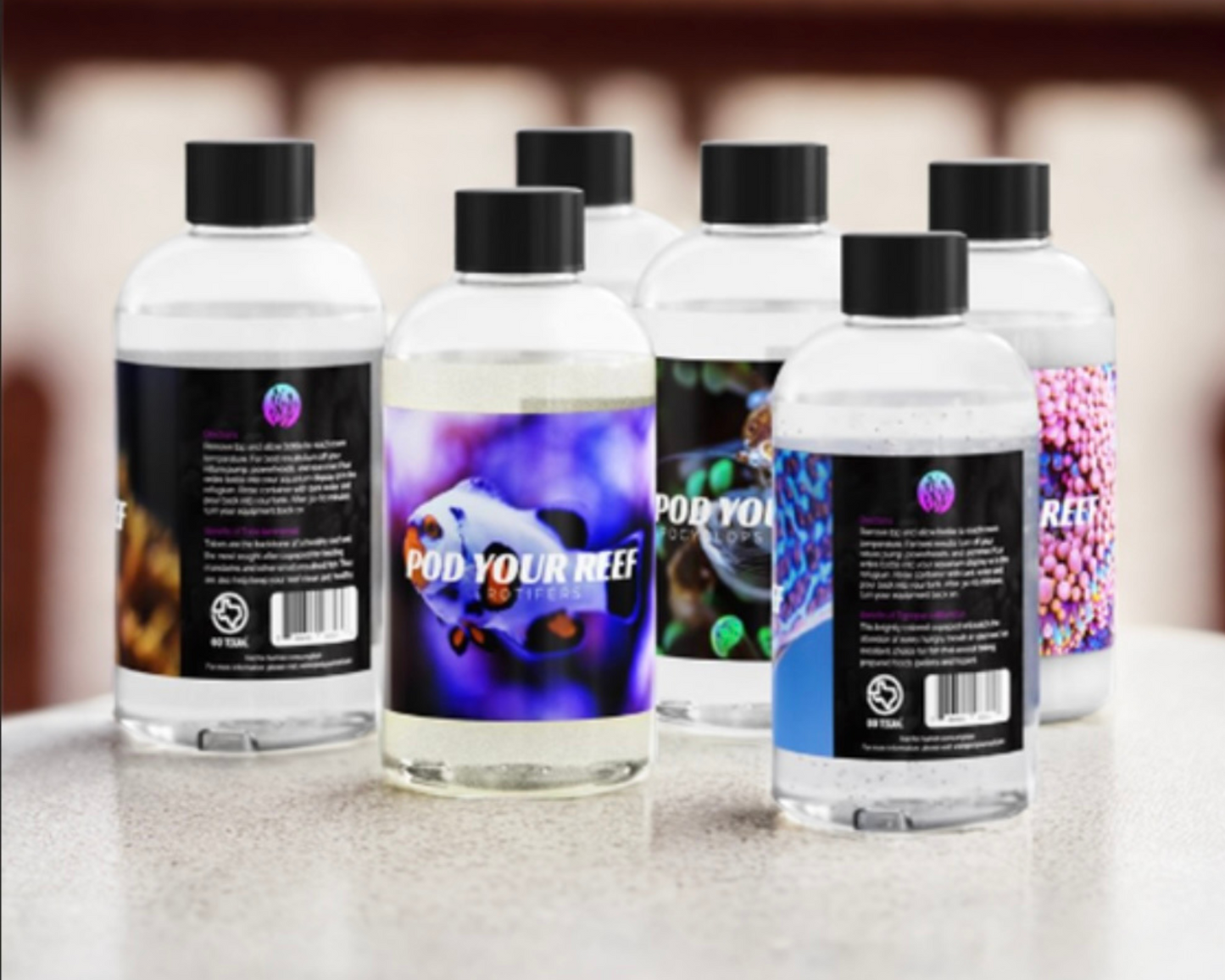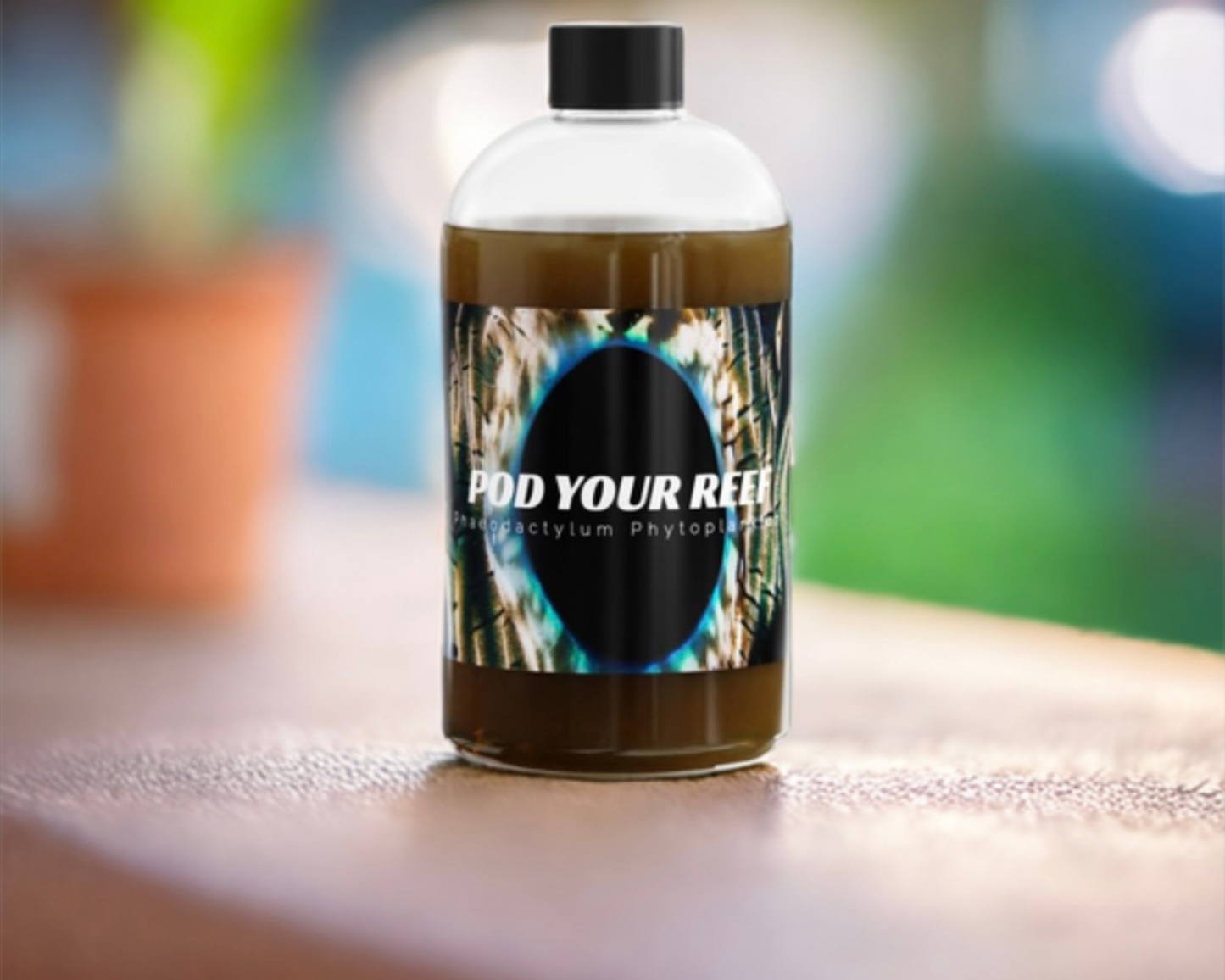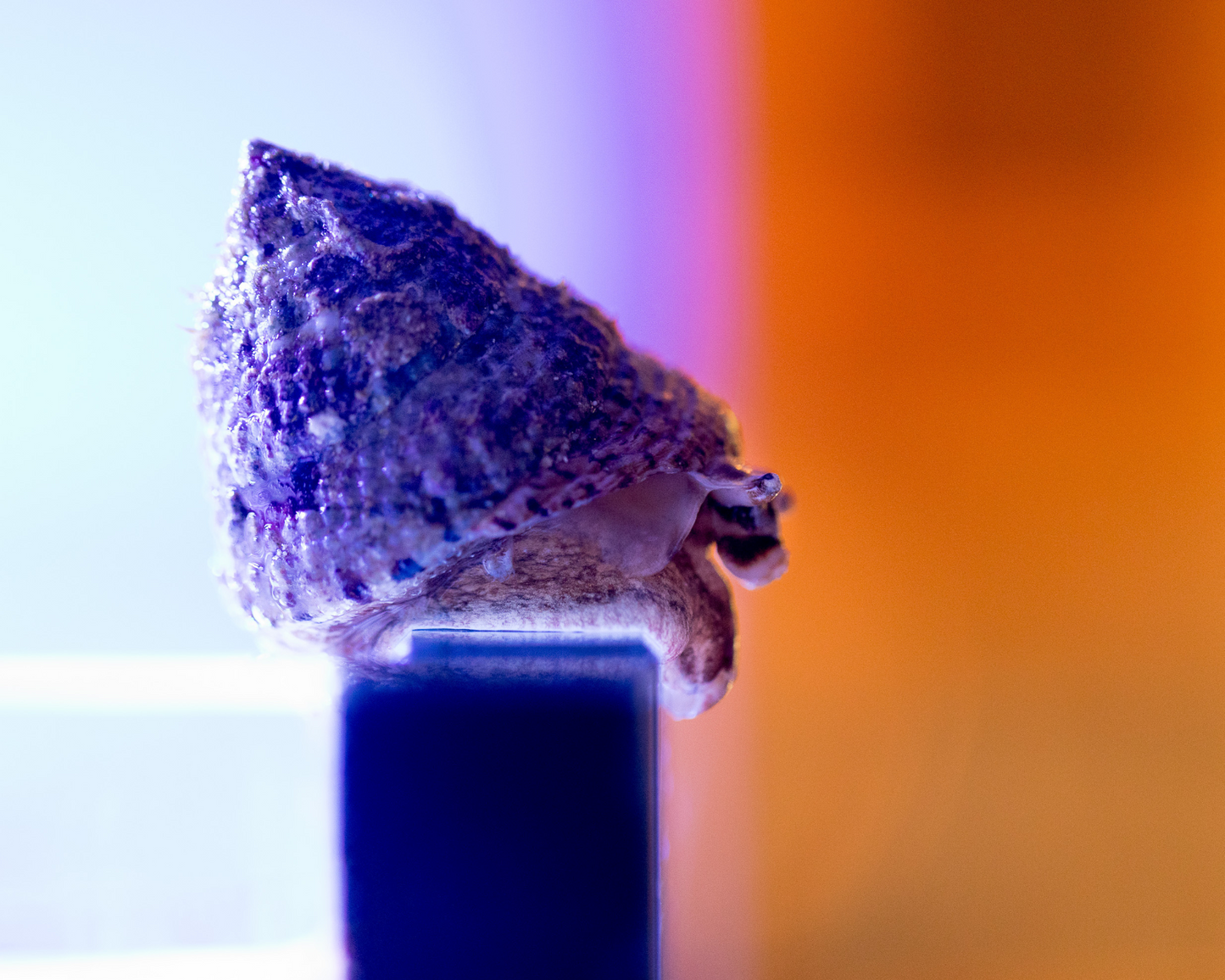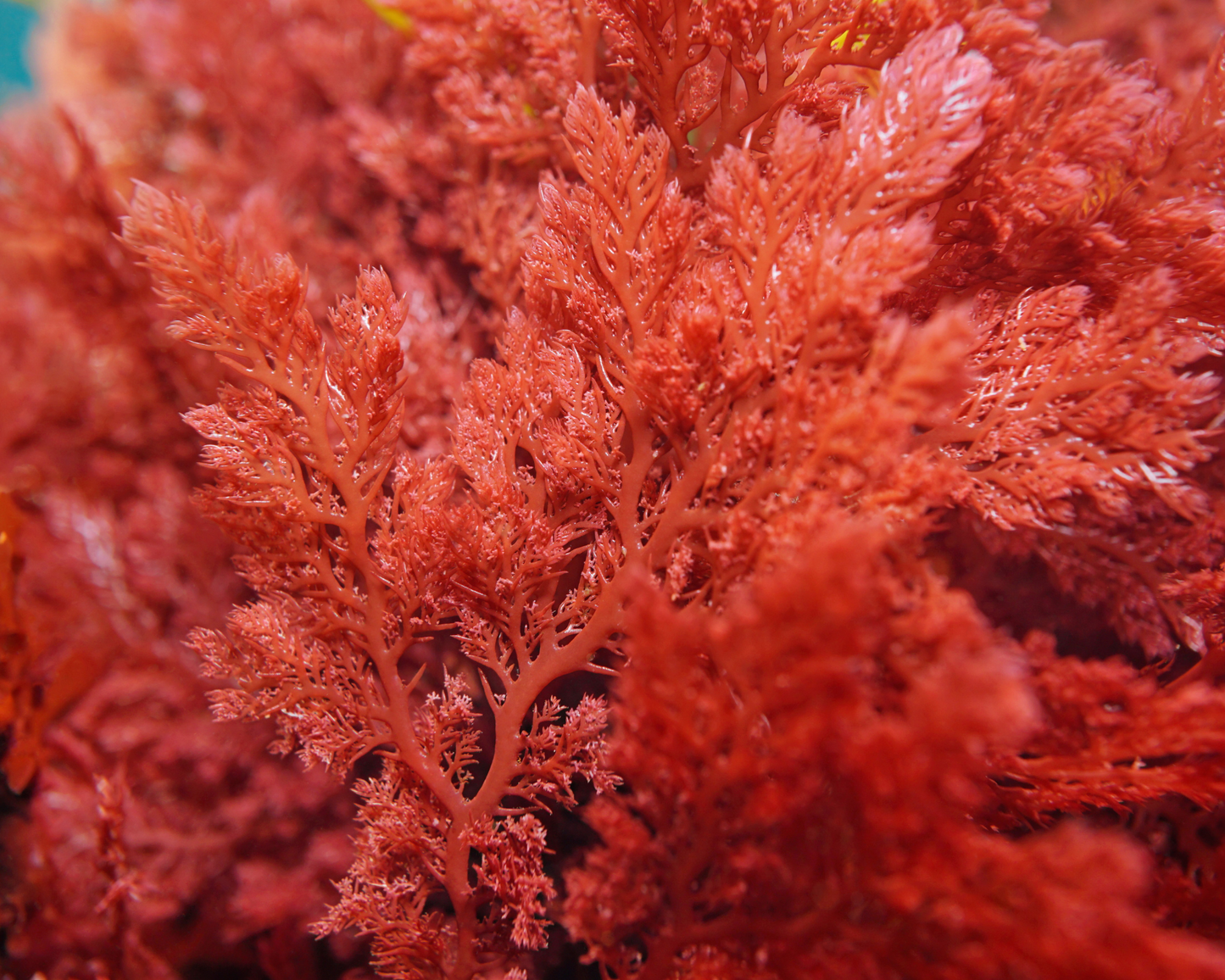Save $10

Amphipods vs Copepods in Reef Tanks: Which Should You Use?
Introduction: Every reef aquarist eventually encounters the tiny critters known as “pods.” You might have shined a flashlight into your aquarium at night and seen minuscule bugs skittering over the rocks and glass. If so, congratulations, you’ve got pods! In reef hobby slang, “pods” refers to the multitude of amphipods and copepods that colonize our tanks and refugiums. These little crustaceans form a critical part of the natural reef ecosystem, acting as both cleanup crew and live food source. But not all pods are equal. Copepods and amphipods have distinct differences, and as a hobbyist you may be wondering which type to add to your reef tank (and when). Should you seed your tank with tiny copepods first, or introduce larger amphipods? Or is a combination best for a thriving, biodiverse aquarium?
In this in-depth guide, we’ll explore what copepods and amphipods are, how they differ, and their specific roles in a reef tank. We’ll compare their size, diet, and reproductive habits, and give practical advice on which to use for various aquarium needs. By the end, you’ll understand whether amphipods vs. copepods is really a competition or a collaboration – and how to balance both for a healthy, self-sustaining reef. Let’s dive in!
What Are Copepods?
Copepods are tiny planktonic crustaceans found in oceans, reefs, and even freshwater. In the wild they are a vital part of the plankton food web, serving as a primary food for many fish and corals. In aquariums, copepods appear as little white specks (typically 0.5–2 mm in length) crawling on glass or floating in the water column. They have a teardrop-shaped body with a single simple eye (right in the middle of their head) and antennae, giving them a “bug-like” appearance. Copepods are relatively simple in structure for example, they lack a true heart or gills and instead absorb oxygen directly through their exoskeleton. Despite their small size, they play huge roles in our reef tanks.
Types of Copepods for Reef Tanks (Tisbe, Tigriopus, Apocyclops)
Not all copepods are the same. Reef keepers commonly culture or buy several hardy species of copepods, each with unique strengths:
-
Tisbe biminiensis: A small harpacticoid copepod that crawls on surfaces. Tisbe pods are extremely prolific breeders – each female carries dozens of eggs, and they multiply quickly in warm, high-salinity reef conditions. They specialize in eating settled detritus and benthic (surface) algae, sneaking into tiny crevices to clean up waste. Tisbe are excellent for seeding new tanks because they rapidly establish a self-sustaining population of “micro-cleaners.”
-
Tigriopus californicus: Commonly called “tiger pods,” these copepods are larger and more reddish in color. Originally from temperate tide pools, Tigriopus are remarkably hardy and tolerant of a wide range of salinity and temperature. They reproduce a bit more slowly than Tisbe, but they eat a broader range of foods – from microalgae to detritus – and can even consume larger food particles. Tigriopus’s larger size makes them a nutritious prey for fish; they are known to accumulate beneficial pigments like astaxanthin from their algal diet, which can enhance fish coloration.
-
Apocyclops panamensis: A cyclopoid copepod with behavior that bridges both worlds – Apocyclops adults crawl on surfaces like harpacticoids but also swim up into the water column to feed. They breed rapidly and tolerate a wide salinity range. Apocyclops tend to prefer slightly lower salinities (brackish conditions), but they survive in full-strength reef water and will happily consume suspended algae and detritus. Because they venture into open water more than Tisbe, Apocyclops pods are readily eaten by fish and corals in the display. Many reefers find a mix of Apocyclops and Tisbe provides great coverage of the tank’s ecological niches
Feeding Behavior and Habitat of Copepods
Copepods are often called “micro-herbivores” or grazers. Most reef copepods feed primarily on microalgae (phytoplankton) and bacterial biofilms, along with very fine detritus. In a tank, you’ll see them grazing on film algae on the glass and rocks or filtering the water for tiny particles. Dosing live phytoplankton (such as Nannochloropsis or Tetraselmis) regularly can boost your copepod populations by providing a constant food source. Well-fed copepods, in turn, become incredibly nutritious live food for fish and corals – they are packed with protein and omega-3 fatty acids from all the algae they eat.
In terms of habitat, copepods tend to thrive in refugiums, sumps, or any low-flow area of the tank where they can multiply without being immediately devoured. They hide in rock crevices, macroalgae (like chaetomorpha in the refugium), and even filter floss. Given some “safe zones” away from fish predators, copepods will continuously breed and sustain a population. They go through several life stages, starting as free-swimming larvae (nauplii) and later maturing into crawling adults. This means they occupy both the water column (when young) and the surfaces/substrate (when adult), cleaning as they go. In a mature reef aquarium with a healthy pod population, copepods become an essential natural food source – tiny live prey that many fish (like mandarins, dragonets, wrasses, etc.) constantly hunt for.
What Are Amphipods?
Amphipods are another type of crustacean often found in reef tanks, but they are much larger and more robust than copepods. If copepods are like gnats, amphipods are more like little shrimp. Adult amphipods in aquariums typically measure around 5–10 mm long, easily visible to the naked eye. They have laterally compressed bodies (flattened from side to side) and a distinct curved shape, leading to their nickname “scuds” or “side-swimmers.” Morphologically, amphipods have two pairs of antennae and multiple leg segments – if you look closely you can see them scrabbling around on claw-like appendages. Unlike copepods, which have a single eye, amphipods have two compound eyes and more complex organs, including gills for breathing and even a tiny heart to pump blood. In essence, an amphipod is a miniature shrimp-like creature that often hitchhikes into our tanks on live rock or macroalgae.
Morphology & Size
Most amphipods in reef tanks belong to the genus Gammarus or related genera. They have a curved, segmented body with a distinct head and tail. When resting, they often curl up in a “C” shape. Their exoskeleton is thicker than a copepod’s, and they can appear whitish, gray, or brownish depending on diet (sometimes taking on a green tint if they’ve been eating algae). Because of their larger size (many times bigger than copepods), amphipods are easy to spot darting in and out of rockwork or zooming across the sand, especially after lights-out. They tend to hide during the day and come out more at night. If you clean your filter socks or refugium sponges, don’t be surprised to find several amphipods wriggling around – they love these dark, food-rich hiding spots.
Amphipods have a more advanced anatomy than copepods. They possess jointed legs for crawling and swimming, true gills to draw oxygen from the water, and even brood pouches for their young. A female amphipod carries fertilized eggs in a ventral pouch until they hatch, releasing fully formed tiny amphipods into the tank. (Copepods, by contrast, usually release free-swimming larvae rather than fully formed miniatures.) This reproductive difference means amphipods produce fewer offspring per brood, but each baby amphipod is relatively larger and more developed.
Feeding Habits of Amphipods
Amphipods are often described as scavengers or detritivores. They aren’t picky eaters at all – these little omnivores will munch on almost any organic matter they can find. In a reef aquarium, amphipods primarily consume detritus (decaying plant and animal matter), leftover fish food, fish waste, and dead algae. They will happily chew on soggy fish pellets that fell behind the rocks, or graze on decomposing leaves from macroalgae. By cleaning up detritus and uneaten food, amphipods perform a valuable “janitor” role in the tank, preventing excess waste buildup.
Many amphipods also graze on algae, including film algae and sometimes even nuisance algae like hair algae. However, they are not as efficient at consuming microalgae as copepods are – amphipods tend to focus on larger chunks of material. Think of amphipods as the heavy-duty clean-up crew handling the bigger scraps, whereas copepods are the fine-detail cleaners scraping away microfilm.
Because amphipods are larger and mobile, they become tempting prey for many fish and invertebrates. Fish with a taste for live foods (wrasses, dwarf angels, dottybacks, etc.) will eagerly hunt amphipods if present. Even some corals or anemones might grab an amphipod if one drifts by.
In fact, amphipods often serve as a natural food source in reef tanks for “pod-eating” fish that have slightly bigger mouths. For example, a spotted mandarin dragonet might ignore a big amphipod (mandarins prefer smaller copepods), but a hungry wrasse or hawkfish will pounce on it.
Note: It’s common for reef keepers to discover amphipods in their tanks without ever intentionally adding them. Amphipods frequently hitchhike on live rock, live sand, or chaeto algae from another system. Once a few get in, if conditions are good (plenty of food and hiding places), they can rapidly multiply. Before you know it, you have a healthy amphipod population cleaning your tank’s nooks and crannies!
Key Differences Between Copepods and Amphipods in a Reef Tank
Now that we’ve introduced both pods, let’s compare copepods vs. amphipods side by side. Both are beneficial micro-crustaceans, but they differ in size, behavior, and how they contribute to your aquarium’s ecosystem. The table below summarizes the key differences:
| Aspect | Copepods (“Pods”) | Amphipods (“Scuds”) |
|---|---|---|
| Size & Visibility | Tiny: ~0.5–2 mm (speck-sized); often barely visible without magnification. | Much larger: ~5–10+ mm; easily seen crawling on rocks and in filters. |
| Body Shape | Teardrop or oval body; 1 pair of antennae; 5 pairs of small legs; single simple eye on head. | Shrimp-like, laterally flattened body; 2 pairs of antennae; 7 pairs of legs; two prominent eyes. |
| Primary Diet | Microalgae (phytoplankton), bacterial film, and very fine detritus. Filter-feeds and grazes on surfaces. | Detritus, decaying matter, leftover food, and some algae. Scavenges larger particles (fish waste, dead tissue) from substrate. |
| Reproduction | Rapid breeders: many species produce eggs or nauplii continuously; can boom in population given food. Short generation time. | Slower breeders: carry fewer, well-developed young in brood pouch; population grows steadily but not explosively. |
| Tank Role | Micro-cleaners – scour biofilm and algae off rocks, glass, and crevices. Form base of food web as plankton for corals and small fish. | Macro-cleaners – consume bulk detritus and leftover food, helping keep the tank clean. Serve as live prey for larger fish and inverts. |
| Active Period | Both day and night (many species forage on glass after dark; nauplii drift day/night). | Largely nocturnal – hide in rock by day, forage after lights out. Often seen in sump filters anytime. |
| Nutritional Value | High in omega-3 fatty acids (algae-rich diet) and protein; very nutritious for fish and coral feeders. Soft-bodied and easy to digest. | Protein-rich but lower in fatty acids (detritus-based diet); still a good live food source for fish needing larger prey. |
| Examples | Tisbe, Tigriopus, Apocyclops (common reef-safe copepods). | Gammarus (reef amphipod), Caprella (skeletal "stick" shrimp, less common). |
As the table shows, neither is “better” in an absolute sense – they each fill different niches. Let’s break down a few of the most important differences in practical terms:
Size and Visibility
The most obvious difference is size. Copepods are microscopic to barely visible, whereas amphipods are mini-shrimp you can see easily. If you peer closely at your aquarium glass and notice tiny white dots scooting around, those are likely copepods. Amphipods, by contrast, you might spot from across the room when the lights are off – they’ll dart for cover when you approach. Because of size, amphipods are more likely to be caught and eaten by fish quickly, whereas many copepods can evade predation by hiding in tiny refuges or simply being too small for fish to bother with.
From a hobbyist’s perspective, size also affects how you introduce and maintain them. Copepods often come in bottled cultures (swarms of nearly invisible nauplii and adults). You pour them into the tank or refugium and trust that they’re there (even if you can’t see every individual). Amphipods, if purchased or collected, are netted or scooped and are visibly jumping around. You can literally see amphipods hopping when you add them to a refugium container. Each amphipod also contributes more biomass than a copepod – a few amphipods can do the cleaning/eating equivalent of hundreds of copepods when it comes to larger waste.
Reproductive Rate
Copepods generally reproduce much faster than amphipods. In a well-fed system with no predators, a copepod population can boom exponentially. For example, a single female copepod might lay dozens of eggs every few days, resulting in continuous generations of nauplii. This rapid reproduction is why reefers can culture copepods en masse and need to replenish them if fish (like mandarins) are constantly eating them. Amphipods, on the other hand, breed at a slower pace. A female amphipod carries a limited number of eggs in her brood pouch for a period, and those young take time to grow to breeding age. So while amphipods can certainly establish a robust population, they don’t typically reach the sheer density that copepods can.
One practical upshot: if you add a batch of amphipods to your tank, they might take longer to increase in number compared to copepods noticeably. Copepods can sometimes seem “invisible” but then suddenly you find thousands in your refugium after a month of feeding phyto. Amphipod populations grow more linearly. This also means copepods can recover faster from predation, which is vital if you have fish constantly eating them. Amphipods, being larger and fewer, can get wiped out more easily by a hungry wrasse if they don’t have safe refuges.
Tank Roles: Clean-Up Crew vs. Plankton Feeders
Both copepods and amphipods contribute to a cleaner, more natural reef tank, but they target different “messes.” Copepods excel at micro-cleaning: they browse on microalgae films (helping to keep glass and rocks clear of that green haze) and pick up tiny bits of detritus that settle in crevices. They essentially convert microscopic waste and algae into nutritious biomass (themselves), which then becomes food for other creatures. Amphipods are the heavy-duty clean-up crew: they’ll tackle bigger chunks of detritus, eat dead animal or plant matter, and even chew up nuisance algae or uneaten fish food before it can rot. In tandem, both types of pods provide a comprehensive clean-up team that reaches almost every corner of the tank.
Nutritionally, copepods are usually considered a superior live food for small-mouthed fish and corals because of their algae-rich diet (they contain fatty acids and carotenoids that boost fish health and color). Amphipods are excellent food for larger fish – a chunky wrasse or even a picky eater like a Mandarin dragonet will relish amphipods if they can fit them in their mouth. However, many filter-feeding corals and very small fish can’t swallow an adult amphipod, whereas they can consume copepod nauplii or adults readily. Therefore, copepods = best for tiny feeders, amphipods = bonus food for bigger eaters.
It’s worth noting that amphipods, due to their size advantage, can sometimes dominate an environment to the detriment of copepods. There are reports (and scientific reasoning to back it up) that an explosion of amphipods might lead to declines in copepod populations, either through competition or direct predation. Essentially, a big amphipod might snack on a small copepod if it crosses paths, and amphipods can outcompete copepods for certain detritus food resources. This dynamic is something to be aware of, which leads to our next question:
Which One Should You Add First?
When starting a new reef tank or looking to boost your microfauna, should you prioritize copepods or amphipods? The answer depends on your tank inhabitants and goals. In many cases, seeding copepods first is wise, especially in a young tank. Copepods will help establish a foundational food web and are generally less sensitive to initial water parameter swings as long as some algae (food) is present. Amphipods, being larger, often require a more mature environment and may not find enough detritus to eat in a brand new tank. Let’s consider a couple of scenarios:
Amphipods for Larger Predators
If your primary reason for adding pods is to provide live prey for certain fish, you need to match the pod to the predator. Larger predators, for example, a sixline wrasse, some clownfish, damsels, or even predatory inverts like mantis shrimp, will appreciate amphipods as hearty snacks. Amphipods are big enough for these hunters to chase down and grab. If you have fish that actively hunt during dusk or dawn, amphipods can be a great natural feed to keep them fat and happy.
However, you typically wouldn’t add amphipods before those predators are in the tank or before the tank has an ample supply of detritus to sustain the amphipods. A good strategy is to establish some copepods first (which also serve as food for baby amphipods later), and then introduce amphipods once the tank has aged a bit and you have places for them to hide. Since amphipods often hitchhike in, you might not need to intentionally buy them unless you have a very sterile setup. But if you do, add them after your tank is cycled and has visible microalgae growth or fish producing waste – they’ll need something to chew on. Think of amphipods as the second-wave clean-up crew: great to add when you start feeding fish regularly, so they can mop up excess and breed without starving.
Copepods for Mandarins & Corals
Small, delicate feeders like the famous Mandarin Dragonet (Synchiropus splendidus) absolutely depend on copepods. If you plan to keep a mandarin or other pod-eating fish like scooter blennies or pipefish, you should seed copepods first and abundantly. Ideally, add copepods a few weeks or more before introducing the mandarin, so the pod population has time to multiply without being immediately eaten. Copepods will colonize your live rock and refugium, giving the mandarin a steady supply of hunting opportunities. In this scenario, amphipods are less critical; mandarins usually ignore adult amphipods (too big/tough), and in some cases large amphipods might even outcompete the copepods that mandarins need. So for mandarin keepers, copepods are priority one – you might even continuously replenish them (via bottled pods or refugium culturing) to keep up with the fish’s appetite.
Corals and filter feeders similarly benefit more from copepods than amphipods. Many LPS corals (like sun corals, goniopora, etc.) and even SPS will capture copepod nauplii out of the water column as a nutritious snack. Those tiny planktonic stages are essentially coral food. Amphipods, being too large, are not going to be eaten by corals (with rare exceptions like a big anemone might ingest one). Thus, when thinking of the planktonic food supply in your tank, copepods are the stars.
In summary, if you have a new tank or a tank with primarily small-mouthed fish and corals, start with copepods. If you have larger fish that will hunt pods (and a mature system), amphipods can be introduced thereafter. In practice, many hobbyists add a mix (often sold as “pod kits” containing multiple species) to cover all bases. Just remember: in a brand new sterile tank, neither copepods nor amphipods will thrive without some source of food (microalgae or detritus respectively). Always ensure your system has begun growing a bit of algae or that you are dosing phytoplankton before adding pods.
Pro Tip: When seeding copepods, turn off your return pump and powerheads for a few minutes and add the pods near rockwork or into your refugium. This gives them a chance to settle in cracks and crannies out of immediate reach of fish. Also consider dosing live phytoplankton after adding pods – this “green water” will both feed the new copepods and draw them out into the open water (improving the chances your fish notice and eat some, if feeding is the goal).
Can You Use Both Copepods and Amphipods Together?
Absolutely, in fact, a healthy reef tank often has both copepods and amphipods coexisting. Biodiversity is generally beneficial in aquariums. Copepods and amphipods together provide a more complete clean-up crew and live food web, as we’ve discussed. Copepods handle the small stuff, amphipods handle the bigger stuff. The key is maintaining a balance so that one population doesn’t crash the other.
In a well-managed tank, copepods and amphipods will establish a natural equilibrium. Amphipods will eat some copepods (and their eggs) opportunistically, but they usually will not wipe them out completely, especially if you have plenty of live rock and hiding spots for copepods. Having a refugium greatly helps: this separate chamber (often filled with macroalgae like chaeto) can harbor masses of copepods away from hungry mouths, allowing them to reproduce safely. Many amphipods will stay in the refugium as well, but the copepods being smaller benefit the most from these sanctuaries with fine mesh and dense algae where big amphipods can’t reach easily.
There are a few best practices if you aim to cultivate both pods long-term:
-
Provide ample hiding spaces: Live rock rubble, porous bio-media, or dense macroalgae (e.g. a ball of chaetomorpha) in your sump or display give copepods tiny crevices to escape predation. Amphipods are larger and can’t infiltrate every nook, so the copepods have safe zones to breed.
-
Feed phytoplankton regularly: A steady input of live phytoplankton will keep copepods well-fed and breeding, which helps maintain their numbers even if some get eaten. Phytoplankton also indirectly feeds amphipods by increasing the overall food (algae and detritus) available. Aim to dose phyto a few times a week – your pods (and filter-feeding corals) will thank you.
-
Avoid overfeeding fish: Overfeeding leads to excess detritus, which can cause the amphipod population to explode and potentially impact the copepod population. Feed fish responsibly so that pods supplement the cleanup, rather than being solely responsible for waste processing.
-
Regularly replenish copepods: If you notice a significant decline in your copepod population (especially in tanks with heavy pod-eaters), consider adding fresh copepods periodically. This ensures your tank always has a baseline population and also introduces genetic diversity.
-
Predator management: Certain fish, like wrasses or dragonets, will naturally keep amphipod numbers in check If you have an overabundance of amphipods and a shortage of copepods, introducing (or already having) such a predator can restore balance. Conversely, if you want to protect copepods, ensure they have refuges as mentioned, and avoid adding too many amphipod-hungry fish.
When managed properly, having both amphipods and copepods creates a synergistic effect in your reef tank. They contribute to improved nutrient cycling (breaking down waste into usable forms), provide a continuous supply of live food, and enhance overall biodiversity. Many advanced reefers cultivate thriving populations of both, achieving a sort of “mini ecosystem” that can self-sustain for long periods.
Conclusion: Striking the Right Balance and Next Steps
In the amphipods vs. copepods debate, the truth is that most reef tanks benefit from both. Each type of “pod” plays a role in mimicking the natural reef environment in your aquarium. Copepods are the tiny powerhouses that keep microalgae in check and feed the smallest mouths in your tank. Amphipods are the larger workhorses that patrol for leftovers and offer nourishment to bigger fish. Rather than choosing one over the other, consider the needs of your specific livestock and the maturity of your tank:
-
New setup with small fish or corals? Start with copepods to establish that baseline food web.
-
Established tank with lots of rock (and maybe larger fish)? Add amphipods (if they aren’t already present) to bolster the clean-up crew.
-
Ideally, seed multiple copepod species (like Tisbe, Tigriopus, Apocyclops) along with amphipods for a diverse, resilient microfauna population.
The goal is a balanced population where pods continually reproduce but also get eaten – providing an ongoing, natural food source that helps your fish show their instinctual behaviors. Watching a mandarin hunt pods or a wrasse dart after an amphipod is not only fascinating, it’s a sign of a healthy tank.
As you cultivate your pod populations, remember to support them with proper conditions: keep up phytoplankton feeding, maintain good water quality, and give them refuges to avoid total predation. With time, your “pod army” will take root and contribute to a self-sustaining reef ecosystem.
Finally, if you’re ready to boost your tank’s pod life, check out Pod Your Reef’s live copepods (and even amphipods) in our Copepods & Rotifers collection. We provide cultured reef-safe copepods (like Tisbe, Tigriopus, Apocyclops) and live phytoplankton to feed them. You can also explore our Rotifers and Phytoplankton collections – rotifers make great supplemental zooplankton for coral feeding, and phytoplankton is the fuel that keeps pod populations thriving. By seeding your tank with quality live pods and regularly dosing phyto, you’ll be on your way to a vibrant, dynamic reef aquarium teeming with natural life.
Happy reefing, and may your tank always be crawling (in a good way) with beneficial pods!
